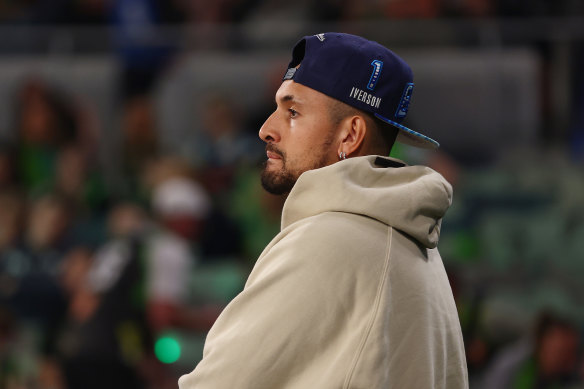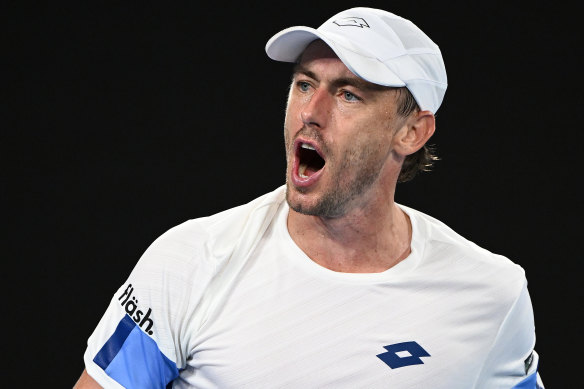- Updated
- Sport
- Tennis
- Australian Open
This was published 1 year ago
‘I hated waking up and being Nick Kyrgios’: Tennis star opens up on his mental health battle
By Marc McGowan
Nick Kyrgios is taking an active role in helping people through their mental health challenges after going public with his own self-harming.
The Australian tennis star, who remains sidelined with a wrist injury, revealed in February last year that he had “suicidal thoughts” at his lowest ebb and has detailed his mental health challenges on several forums since, including Netflix’s Break Point.

Nick Kyrgios at a recent NBL game between the South East Melbourne Phoenix and Melbourne United.Credit: Getty Images
Kyrgios’ latest appearance was on Piers Morgan Uncensored on TalkTV, where he revisited being admitted to a psychiatric ward in London and contemplating suicide following Wimbledon in 2019.
He wore a compression sleeve at that event to cover scars on his arms from repeated self-harming, with Scottish champion Andy Murray becoming aware of the issue and alerting the Canberran’s ex-manager, John Morris.
Kyrgios’ willingness to be so vulnerable and tell his story appears to have struck a chord with others going through a difficult time.
“I’ve almost been a beacon for people who are struggling. When they feel like they’re overwhelmed, and they’re going towards drinking, drugs and stuff; they open up, and they feel like I’m relatable,” Kyrgios said.
“That’s been the most powerful thing in my career; people coming to me with genuine issues. They send me photos in my Instagram, direct messages, self-harming and genuinely wanting to commit suicide.
“I have conversations with these people. Sometimes, I’ve had phone calls with these people. That’s making a real difference, and I’m just really proud.”
Kyrgios said his period of self-harming lasted somewhere between 18 and 24 months, and that he remained thankful for Murray’s intervention.
“It was pretty dark, to be honest,” he said.
“I won tournaments on the professional tour [but was] drinking every night, self-harming, burning things on my arm, cutting myself for fun. It became an addiction of pain. I hated myself. I hated waking up and being Nick Kyrgios.”
“That’s been the most powerful thing in my career; people coming to me with genuine issues.”
Australian tennis star Nick Kyrgios
Murray, a triple-grand slam winner, has long been one of Kyrgios’ closest allies on the tennis tour.
“Andy was always a big supporter of me,” Kyrgios said. “As soon as I came on the tour, he kind of saw a work-in-progress and took me under his wing ... he was always someone that was looking out for me.
“He saw [the self-harm] and said, ‘What’s that on your arm?’ It was pretty bad at that stage. Andy obviously was trying to give me advice on it, but I was just so stuck in my ways at that time that I didn’t listen. Obviously, I’m very thankful. I thank him a lot.”
If you or anyone you know needs support, call Lifeline 131 114 or Beyond Blue 1300 224 636.
Tennis revolution is no simple plan: Why the sport must unite
Respected tennis veteran John Millman believes the sport’s biggest stars could benefit financially from an F1-style revamp but fears the gap may widen between the haves and have-nots.

John Millman.Credit: Getty Images
Tennis could be headed for a revolution, with top-ranking officials in charge of the Australian Open, Wimbledon, US Open and French Open plotting the creation of a premium tour resembling the Formula 1 calendar, as The Athletic first reported.
The concept would see the grand slams partner with at least 10 of the major ATP and WTA tournaments across the globe, starting with the Masters 1000s, and effectively be pitched as one elite package for broadcasters, sponsors and fans.
Millman, 34, will retire at the end of next year’s home grand slam after a career that included representing Australia in Davis Cup and the Olympics, making the 2018 US Open quarter-finals, and reaching a best ranking of No.33 in the world.
He experienced the highs and lows of the sport and is a well-established voice of reason, a significant factor in him being elected to the ATP’s player council, a role he held from 2020 to the end of last year.
Millman is fairly supportive of a premium tour, but most interested in a unification of the governing bodies rather than the segmented version tennis operates under at present.
“The benefit of the concept is a more attractive premium product to investors,” Millman told this masthead.
“That makes it potentially more attractive to the fans, while probably locking the players into a more fixed schedule. [But] I’d say it probably has the potential to further widen the gap in opportunity between the top-ranked players and those trying to get up the ranks.
“I think there is also the potential, from a domestic level, of not having free-to-air access to watching tennis … if [the rights] were sold exclusively to a streaming provider, for example.”
Millman was aware of these types of discussions while he was on the player council and said his peers “generally” backed the idea if it meant they could possibly make more money.
However, this is a somewhat rare act of unity from the slams, and Millman is yet to be convinced the collaboration will eventuate.
“Tennis is quite fragmented – there are different governing bodies [ATP, WTA, ITF and the grand slams] often pulling in different directions,” he said. “I think unifying them is more difficult than you’d think.”
Millman’s blueprint for tennis would see the sport adopt a multi-tour model similar to golf, whereby more players would have the chance to make a living.
The greatest challenge tennis faces is finding a way to financially support more than a couple of hundred players in each gender, especially with ATP chairman Andrea Gaudenzi on record as saying it is a “very star-driven sport”.
The ATP has introduced a three-year trial program called Baseline, starting in 2024, that will provide tiered but guaranteed base earnings for the top 250-ranked singles players each season.
“Currently, there’s one tour in men’s tennis, the ATP, and WTA for women,” Millman said.
“You need ATP and WTA points to qualify for every tournament. I think lack of competition is never a good thing. It would be like having one electricity provider or one grocery shop. There’s no incentive or competition to create better conditions for players.
“I like the fact that golf has multiple tours. I don’t like that the PGA still has most of the power, but I think multiple tennis tours would create more opportunity for jobs, and a greater incentive for the tours and tournaments to provide the best conditions for players.
“I think anything that benefits the players is a good thing.”
Meanwhile, Davis Cup spearhead Alex de Minaur, Matt Ebden, Rinky Hijikata, doubles world No.1 Storm Hunter, Alexei Popyrin and Max Purcell are the nominees for this year’s Newcombe Medal, held on December 11.
De Minaur was a joint winner with Ash Barty in 2018, and is the favourite this time around after reaching a career-high ranking of No.11, winning his first ATP 500 title and making his maiden Masters 1000 final.
News, results and expert analysis from the weekend of sport sent every Monday. Sign up for our Sport newsletter.